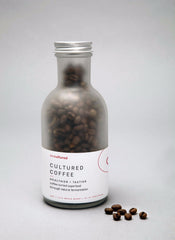The Science Behind These Common Fermented Foods
How much do you know about your favorite fermented foods?
Fermentation typically refers to the chemical conversion of carbohydrates such as starches or sugars in food by beneficial bacteria, yeasts, or other microorganisms into alcohols and acids.
The naturally-occurring process has been a cornerstone of human civilization for millennia and helped produced some of the tastiest and most digestible foods in our pantries.
In this blog post we explore the origins and ingredients behind some of the most common fermented foods today.
Fermented Grains
Fermented grain such as barley, wheat and spelt either as whole grain or flour is a healthier alternative to non-fermented options.
As grains are fermented much of the phytic acid is neutralized as part of the chemical reactions in the food that take place through the action of microbes. This acid is the principal storage form of phosphorus in many plants and also a key trigger for people with gluten sensitivities.
Similarly, essential vitamins and protein locked in the grain become more bioavailable through the fermentation process.
Sourdough Bread
 Naturally occurring microbes, namely lactobacilli and yeast, convert carbohydrate in milled grain into lactic acid and carbon dioxide, which makes the bread rise.
Naturally occurring microbes, namely lactobacilli and yeast, convert carbohydrate in milled grain into lactic acid and carbon dioxide, which makes the bread rise.
A food with an ancient story, it's likely that sourdough bread is one of those happy accidents of history that led to a firm partnership between microbes and men. Used in a number of breads, especially rye bread, the origins of sourdough date back thousands of years, or a long as civilization has cultivated grain.
This technique is used to make bread from a number of grains including teff, sorghum, maize (corn), wheat and beyond.
Beer

Made from cereals like wheat, maize, barley and even rice, beer is a typically alcoholic fermented beverage that also dates back to the origins of grain cultivation.
Initially germinated grains are mixed with hot water to form a mash. Mashing activates enzymes in the grain to break down starch into sugars.
The conversion of starches into sugars is visible as a sweet, malty solution called a wort.
Next, the solution is filtered to remove the grain husks and solids using a process called lautering. At this point the wort is mixed with hops for flavor and boiled to halt further enzymatic conversion.
Once the liquid has cooled, sugars in the wort are converted into alcohol through fermentation triggered by the addition of wild or industrially-cultivated yeasts.
As alcohol prevents harmful bacteria from taking hold, alcoholic beverages like beer or hard cider were typically safer to drink than regular water before the era of water sanitation. These days the beverages have seen a resurgence in popularity as a craft alcoholic beverage.
Sake

Sake (saké) is an alcoholic drink made from fermenting rice using a process called amylolytic bacterial acid fermentation.
Rice grains are polished to remove the bran, which holds the oils and fiber, then fermented in a similar way to beer to convert starches into sugars, then alcohol.
However unlike beer sake doesn't require a two-step process. Instead humidified rice grains are immersed in water then steamed. Once the grains have cooled a natural microorganism, Aspergillus oryzae (a mold), is added and allowed to natural ferment the rice over several days.
More water and rice are gradually added to build up the mash solution. The mash then ferments at approximately 15–20 °C (59–68 °F) for 2–3 weeks.
Aspergillus oryzae contains enzymes amylase, glucoamylase and protease needed to hydrolyze nutrients in rice. This encourages the growth of yeast, which in turn converts sugars into alcohol.
Fermented Proteins
Cheese
 Cheese is essentially a stable form of curdled milk. Milk sugars (both dairy and plant-based) are converted into lactic acid by microbes and the addition of enzymes from rennet or other plant-based sources to make a savory food.
Cheese is essentially a stable form of curdled milk. Milk sugars (both dairy and plant-based) are converted into lactic acid by microbes and the addition of enzymes from rennet or other plant-based sources to make a savory food.
The chemical composition of the milk, exact cultures used to curdle the milk and how the curds are processed and stored impact the flavor and texture of the resulting cheese.
While the precise origins of cheesemaking predate historical record, it's thought production originates from the natural curdling that took place in fresh milk transported in containers made from the stomachs of cows and other ruminants, which contain rennet.
Nowadays cheesemaking technology and know-how can be applied to any source of milk including nut milks, with vegan cheese a growing trend among consumers in the United States and beyond.
Tofu
 Tofu is a form of vegetable protein made from the curds of soy beans native to East and Southeast Asia.
Tofu is a form of vegetable protein made from the curds of soy beans native to East and Southeast Asia.
The word has its origins in the Chinese word for "fermented," with the food a documented staple in China and Japan for thousands of years.
Some form of salt-based coagulating agent like nigari (magnesium chloride), calcium sulfate or even sea water is added to cleaned, soaked and ground beans to bind oil and protein from the beans together.
Soy milk is thickened and pressed into solid blocks by squeezing out excess water. The result is often flavored or marinated then cooked or blended with other foods to make a protein-rich, plant-based meal.
Tempeh
A traditional Indonesian fermented food, tempeh is produced by culturing soaked, hulled and party-cooked soy beans and other grains like barley until they bind together in a brick-like form.
An acid, such as vinegar, is added to the unfermented beans to lower the pH of the beans and encourage natural fungi, primarily Rhizopus oligosporusto or Rhizopus oryzae, to culture the food.
Tempeh's fermentation process and use of the whole bean provides more protein and nutrients than tofu. It has a firm texture and nutty flavor that holds up well during cooking.
Fermented Vegetables
Kimchi
 Kimchi, like sauerkraut, is made from salted, fermented cabbage.
Kimchi, like sauerkraut, is made from salted, fermented cabbage.
Originating from Korea, the dish contains finely grated vegetables, chopped local cabbage, salt and seasoning - most prominently garlic and chili.
To make kimchi, chopped cabbage is left to soak in a brine solution for several hours, weighted down to support an anaerobic environment that favors the growth of naturally present lactic acid producing bacteria. These bacteria begin to break down the cabbage and start to give the mixture a signature sour taste.
The salt solution is washed off after fermentation has begun, then extra vegetables and fermented spice paste added. The combination is mixed then sealed and left to ferment for at least a day for an umami kimchi flavor to develop.
Sauerkraut
Sauerkraut, a dish most commonly associated with Norther Europe, is similar to kimchi by virtue of it being based on fermented cabbage. The cabbage is more finely shredded, with more fragrant rather than fiery spices added such as juniper or turmeric.
Fermented Fruit
Coffee

The newest addition to the fermented foods list!
While coffee beans may undergo a certain amount of uncontrolled fermentation on the farm, Cultured Coffee is the first secondary-fermented whole bean coffee.
By selecting specific natural microbes, each specialized at certain tasks, the ensuing fermentation creates a coffee that's less likely to irritate the stomach, cause acid reflux or create coffee "jitters."
Cultured Coffee is the first in a new wave of plant-based fermented foods produced using modern technology to standardize and manage the natural fermentation process to perfection.
Cider

Cider, or hard cider as it's known in the United States, is an alcoholic drink made from fermented apple juice, though according to local law the amount of apple juice used can legally vary in each country.
Apple pomace is squeezed using a variety of techniques to extract all the juice. Fermentation then converts the natural sugars in the juice into alcohol.
Yeasts such as Saccharomyces bayanus, a common yeast used in cider and winemaking, carry out this conversion by consuming fruit sugars and releasing carbon dioxide and ethanol (alcohol). The carbon dioxide is what makes cider and some wines sparkling.
The level of fermentation must be carefully controlled by siphoning off dead yeast cells and adding juice before all the sugars are consumed into an airtight cask. This prevents airborne acetic bacteria from taking over, which results in apple cider vinegar or wine vinegar.
Typically cider is slow-fermented by maintaining the juice at a low temperature (4–16 °C or 40–60 °F) to preserve many delicate fruit aromas.
Wine
Wine is an alcoholic beverage made from fermented grape juice or the juice or other sugary fruits like pomegranates. Much like cider, wine is made using the juice of pressed grapes.
Red wine, unlike white, is produced by leaving some of the grape skins and solids - the material containing the red pigment - in the fermenting juice to create a distinct red color. The skins are then removed from the liquid before bottling.
Wild or industrially-cultivated yeasts are the agents that convert the sugars in the fruit juice into alcohol.
We hope you enjoyed this quick fermentation tour! Without the work of microbes our diets would be very boring indeed, not to mention less healthy and fun!
 Learn more about eatCultured's first healthy fermented product: Cultured Coffee.
Learn more about eatCultured's first healthy fermented product: Cultured Coffee.

1 comment
Thank you for the most interesting fermentation culture read..
cheers to you !!